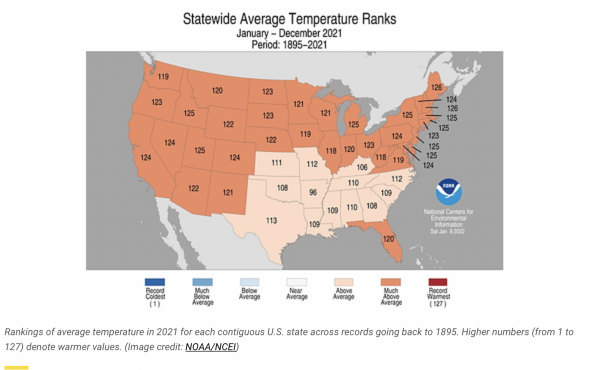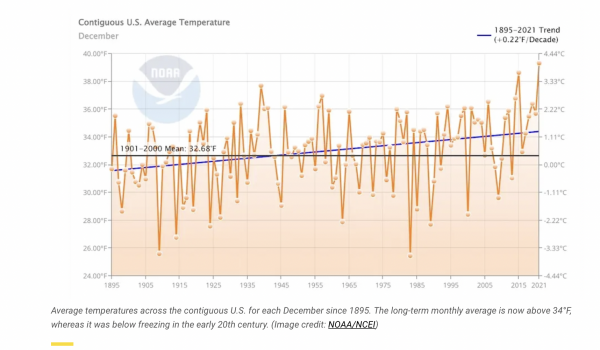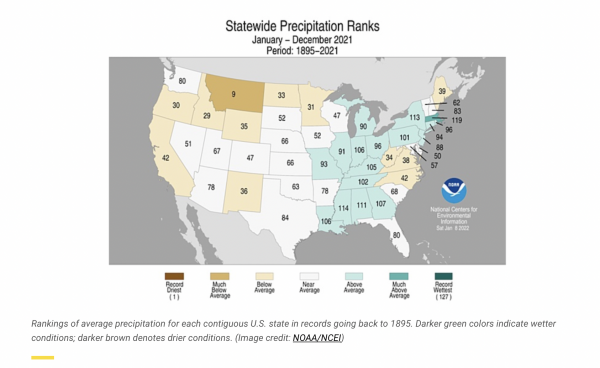By Bob Henson,Yale Climate Connections. Originally published at Yale Climate Connections.
Apart from one catastrophic cold wave, it was warm-season-type threats, from tornadoes to wildfires – regardless of the calendar – that caused most of the weather havoc across the contiguous United States in 2021. The year produced 20 billion-dollar disasters, according to NOAA, the second highest number in inflation-adjusted data going back to 1980. The total cost of 2021’s billion-dollar disasters, $145 billion, was the third highest on record since 1980.
In its preliminary annual round-up of U.S. climate, released on January 10, NOAA found that 2021 was the fourth warmest year on record for the 48 contiguous states. Much of the warmth was concentrated in the second half of the year, the nation’s warmest July-to-December period on record.
(3) 2021 in USA (Lower 48 States) had an average temp. of 54.51F and was the 4th warmest year on records behind 2012,2016 and 2017 (only 0.04F behind 2017). Anomaly was:
+1.23F above the 91-20 norm
+1.69F vs 81-10
+2.55F vs. 61-90
+2.49F vs 20th century average.(see NOAA map) pic.twitter.com/9H3Jl5XMHP— Extreme Temperatures Around The World (@extremetemps) January 10, 2022
The only U.S. years warmer than 2021 in data going back to 1895 were 2012, 2016, and 2017. Every year since 1996 has been warmer across the Lower 48 than the 1901-2000 average, and the seven warmest years on record all have occurred in the 21st century.
The contiguous U.S. has now warmed by around 2.0°F (1.1°C) since 1895, which is close to the global average. That’s a noteworthy trend given that the U.S. was lagging much of the globe in long-term warming during the late 20th century.
Based on preliminary data from NOAA compiled by independent meteorologist Guy Walton, the U.S. in 2021 had almost three times as many daily record maximums (34,569) as daily record minimums (12,644). That makes 2021 the second year in a row with record-high-to-record-low ratios exceeding 2-to-1. A 2009 paper by Walton and colleagues predicted that the typical ratio could reach 20-to-1 by mid-century and 50-to-1 by late in the century.

Every one of the 48 contiguous states was warmer than average in 2021, and 35 of those states had a top-10 warmest year. The annual warmth was only slightly muted across the Southern Plains and Southeast, in large part the result of a brutal cold wave that gripped much of the central United States in mid-February.
A total of 106 stations set or tied all-time record lows in February. The combined intensity and duration of the intense cold were the worst in decades over many locations – especially across Texas, where natural gas outages left millions without heat for days. At least 226 deaths and at least $26 billion damage can be attributed directly to the cold wave, according to NOAA. The impacts may be far greater when considering knock-on effects to the regional economy.
As if to make up for lost time, the nation bolted into warmer territory from March onward. Starting at that point, every interval extending to December (March-December, April-December, May-December, etc.) ended up as the nation’s warmest on record for that interval.
Intense heat and drought led to another summer of destructive forest fires across the West, with smoke and haze spreading far across the eastern half of the nation in July. According to the National Interagency Fire Center, the annual U.S. total acreage burnedin 2021 – 7.13 million acres – was considerably less than the 10-million-plus acres consumed in 2020, 2017, and 2015 and the 8.7 million in 2018, albeit well above the 4.6 million in 2019. The year’s largest fire, and the second largest in modern California history was the Dixie Fire, which raged across 963,000 acres in July. The Dixie and Caldor fires each destroyed more than 1,000 structures in California.
The most tragic heat wave of the year, and arguably the most anomalous heat wave in modern global history, struck the U.S. Pacific Northwest and far southwest Canada in late June and early July. Among the mind-bending temperatures recorded were all-time highs of 108°F in Seattle and 116°F in Portland, both on June 28. A total of 310 U.S. locations set or tied all-time record highs in June.
Early estimates showed more than 600 “excess deaths” from the heat wave in Washington and Oregon and more than 400 in British Columbia. Once researchers have combed through death certificates and other evidence, they may find that the ultimate toll was even higher. A team from the World Weather Attribution project estimated that the heat wave was roughly a once-in-a-millennium event and that it would have been “virtually impossible” without the presence of human-caused climate change.
After a strikingly mild autumn, December 2021 was astonishingly warm over large areas, especially the Southern Plains and lower Mississippi Valley, where many locations had multiple days soar well above 70°F and even 80°F. As noted by independent weather researcher Maximiliano Herrera, Houston’s average temperature for December (including highs and lows) of 67.8°F was not only higher than that of any other December on record, it was higher than for any November!
Similarly, Wichita Falls, Texas, hit 91°F on Christmas Eve (December 24), which melted its all-time high for December and beat any day from any November as well.
Preliminary data for December from NOAA showed a total of 6,321 daily record highs and 910 monthly record highs either broken or tied across the nation.

December’s Unseasonable Destruction
Although there were obvious upsides to the widespread warmth in December – from reduced heating bills to the facilitation of outdoor activity during a pandemic – the persistent record-warm air mass, together with ample low-level moisture from the tropics, laid the atmospheric groundwork for two devastating tornado outbreaks.
The first, on December 10-11, was the nation’s deadliest and likely most damaging on record for any December, with at least 90 fatalities, chiefly across western and central Kentucky, and a record 69 confirmed tornadoes. NOAA estimated the damage at $3.9 billion.
Then, on December 15, a massive cyclone whipped across the central U.S., spawning EF2 tornadoes as far north as Minnesota and Wisconsin – an outbreak unprecedented for December in its northward extent and in the total number of tornadoes confirmed. That total of 100 tornadoes made it one of the largest one-day outbreaks on record for any time of year, and it broke the December record set just five days earlier.
The tornadoes and widespread high winds of December 15 led to an estimated $1.8 billion in damage, according to NOAA.
With unusually cold air pooled across western Canada, a strong polar jet stream cascaded over the Rocky Mountains, leading to a fierce mountain-wave windstorm on December 30 in and near Boulder, Colorado, with gusts hitting 115 mph at Rocky Flats. The winds ripped across terrain parched by record-dry and near-record-warm conditions since September. A wildfire raced across the towns of Louisville and Superior just east of Boulder, shocking residents and sending them fleeing. The fire was Colorado’s most destructive on record and the nation’s most damaging winter wildfire on record, with 1,084 homes destroyed and at least one person killed (see our post from January 4).
Moisture and the Lack of It
As is often the case, precipitation was a mixed bag for the United States when averaged by state and across the full year. Montana recorded its ninth driest year on record, while Massachusetts had its ninth wettest.
Clearly, the nation has veered far from the widespread sogginess that was in place several years ago, when the nation’s wettest 12 months on record were recorded (37.93” from July 2018 to June 2019).

According to the U.S. Drought Monitor, extreme to exceptional drought covered more than 20% of the nation for a total of 41 weeks in the period from November 24, 2020, to November 16, 2021 . No other 12-month period has seen such prolonged coverage of such widespread extreme to exceptional drought since the monitor was established in 2000.
Despite the reach and intensity of U.S. drought in 2021, several devastating flood events were recorded, including a flash flood that took 20 lives in and near Waverly, Tennessee, on the morning of August 21 after a “training” thunderstorm complex dumped hours of torrential rain.
1/7
The State Climate Extremes Committee has verified a new Tennessee 24-hour precipitation record of 20.73”, measured in McEwen, TN on August 21, 2021. Follow this thread for more on the new record. https://t.co/rH3oQ3feSS @NWSNashville @NWSSouthern pic.twitter.com/uaBefi7Xy7— NOAA NCEI (@NOAANCEI) December 20, 2021
As noted by Jeff Masters in his 2021 hurricane-season roundup, eight named storms made U.S landfalls in 2021, the third highest total on record behind 2020 (11) and 1916 (nine). The two-year period 2020-2021 racked up 19 landfalls in the contiguous U.S., six times the average for a two-year period and beating the previous two-year landfall record of 15, set in 2004-2005.
Category 4 Hurricane Ida was the most destructive of the year’s 2021 U.S. landfalls. Ida struck on Louisiana on August 29, making landfall at the key oil industry hub of Port Fourchon with 150 mph winds. Almost half of the homes in Grand Isle were nearly or completely destroyed. Ida caused even more trouble after it had decayed to a post-tropical cyclone and moved into the Mid-Atlantic and Northeast, where it brought torrential rains. The New York City area was especially hard hit, with Ida arriving only a few days after flood-producing rains from Tropical Storm Henri.
The remnants of Hurricane Ida caused flash flooding in and around New York and left at least 29 people dead. Here’s what it looked like around the region. https://t.co/GuQoe40p93 pic.twitter.com/vdUTGKQR7k
— The New York Times (@nytimes) September 2, 2021
All told, Ida led to at least 96 fatalities and an estimated $75 billion in damage, the fifth highest damage toll from any tropical cyclone in the NOAA billion-dollar database.
The other landfalls that caused billion-dollar U.S. damage in 2021, mainly from flooding, were Tropical Storm Elsa (July, $1.6 billion), Tropical Storm Fred (August, $1.3 billion), and Hurricane Nicholas (September, $1.0 billion).


Just throwing this out there.
It seems like we’re not ever going to get our s**t together to take the steps needed to mitigate, never mind reverse climate change.
With that in mind, is it not time to think about abandoning our cities along the coastlines? Take New Orleans for example. Or New York. Or Boston. Or Miami. Would it not be wiser to instead of spending hundreds of millions, if not billions, to protect a city from rising seas and more powerful storms, to only fail over and over, just start over by moving them until we can finally wake up and change our wasteful ways that contribute to climate change? As an aside, why are any permits for new construction being issued in these cities threatened by rising seas? I know, I know,$$$$.
I recognize this is a completely overly simplistic comment to a very complicated situation.
The issue with places like Houston, for example, that was smashed by flooding was because much of their zoning is… nonexistent, and they build a ton of parking lots. The lots cover any wetlands that would otherwise soak up these nasty floods and mitigate the damage; I think that’s the lens we see this through. Yes, people won’t be able to be on the now-coasts 100 years from now, but if it isn’t done in an organized manner (lol) whereby you’re actually covering your tracks with wetland as you retreat, it’s as bad as staying there all along.
It’s time for individuals to take the hard step of bugging out from threatened areas. I am moving to Puget Sound from California. Not perfect but likely better in the respect that PS has lots of water. We coordinated a family move with the next generation(s).
Real Estate in the Seattle-Tacoma area is absurd and that is from a Californian’s perspective. Multiple buyers for every house, and it’s a bidding contest that ends up far above listing price (list:$775k, sale: $832k). I suspect without evidence that some of this pricing includes a “climate change premium”. No proof. This situation will get worse very quickly if it becomes an acknowledged thing.
I am moving to Puget Sound from California.
You and masses of other Californians. The migration has been ongoing for about 10 years, intensifying in the last 5. That’s why the WA real estate market is so absurd and us locals are being priced out of the market. Welcome to the PNW. Hope you like rain and incredibly bad traffic!
You guys really complain about the rain. Seattle averages 38″ of precipitation/year. Far more than Honolulu which can only muster 17.1″/year. In comparison, Huntsville, Alabama averages 54″/year. New Orleans averages 64″/year.
I think that any sort of planned retreat unfortunately falls under the umbrella of “getting our s**t together to take the steps needed to mitigate, never mind reverse climate change.” Plus, all those millions and billions we may spend to try to save coastal cities is money going into the pockets of people with clout.
The worse thing that could happen is for the Federal government to handle climate change in the same way that they have handled the Pandemic. So they would supply a bunch of “floaties” to means-tested citizens via their insurance companies and then tell them that they are now on their own. MSNBC & CNN would tell people to be grateful to the politicians while Fox news would be saying that it was all a hoax. Meanwhile Rachel Maddow would be blaming Russia and Ted Cruz would be blaming China. In short, it would be business as usual.
Here is an incredible article about how much heat the oceans absorbed just last year.
https://www.theguardian.com/commentisfree/2022/jan/11/ocean-temperatures-earth-heat-increase-record
Just like Covid and the lack of Biden actually listening to the experts, he, Trump, and especially Obama have and are doing the same with the climate, basically nothing.
We actually have the tools to do this. Yes we need improvements, but it’s just engineering, it can be done.
People don’t like to actually acknowledge the scope of it nor the solutions, so they figure that recycling is enough or the fact you used low VOC paint in your 7000 sq ft house makes it green ( I kid you not).
I don’t expect enough people to make lifestyle changes to make much of a difference in regards to climate change.
It will have to come from new all non carbon production and carbon removal on the 10,000’s of GW scale and that’s just here in the US.
Unfortunately it’s not going to happen with this administration, just like they can’t figure out one of the simplest easiest to make most effective pieces of safety equipment in the history of the world, masks.
The rising energy prices and the destruction of the standard of living in developed countries will be an across the board mitigation of climate change. It’s the plan, Stan.
Here’s a similar report to what Solarjay mentioned above about ocean temps (sorry, I noticed his comment after I posted mine):
“Thanks to the relentless pace at which humans are adding greenhouse gases to the atmosphere, ocean temperatures in 2021 were “the hottest ever recorded by humans,” according to a report published Tuesday in Advances in Atmospheric Sciences. ”
https://www.yahoo.com/news/the-worlds-oceans-saw-record-warming-in-2021-as-climate-change-continues-apace-193140479.html
Speaking of ocean warmth and the Houston weather mentioned in the original post (December 2021 hottest December or November ever), I was in Galveston over the New Year. My kids were in the water boogie boarding, so I was curious about the temperature. I looked up the daily water temp on Jan 1: 69.4 degrees. I wondered if that was unusually warm, so I tried to find the warmest water temp in Galveston for a January. It _was_ 64.2 degrees according to what I could find, so we were there when it was 5 degrees warmer than it had ever been in January. That’s a huge change.